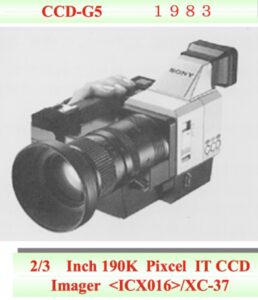We tend to think of consumer cameras and industrial cameras as quite different. Industrial cameras or machine vision cameras are typically PC-based, much more robust, and optimized for using the image for analysis or measurement. Consumer cameras, on the other hand, have functionality optimized for human viewing such as color matching and lighting adjustments. Not as much attention needs to be paid in the camera design to withstand big temperature variations or vibration.
But, without the innovations in the consumer camera market, the machine vision market would not be what it is today. CCD technology started for professional markets like broadcast & security. The real volume came with commercial applications like camcorders (i.e. Sony Handycam). [click here for more on the history of machine vision].

Today we can utilize the speed advantages of CMOS because of the advances in CMOS image sensor technology for cell phone cameras.
There are no big investments in the development for industrial camera products. The R&D that was required to create the sensors in cell phones needed huge volumes to pay off. The industrial camera manufacturers’ challenge is to take consumer components and build a camera that meets the demanding reliability and reproducibility requirements specific to machine vision.
On the flip side, in order to manufacture the latest electronics, such as smart phones, inspection equipment using high-performance machine vision cameras is required. For more details on this, see our previous blog series:
How Increased Smartphones Advance Machine Vision
Dependence on the consumer market, will present more challenges for the machine vision market in the future. The direction of cell phone cameras is smaller, and smaller pixels. Their goal is to have as many pixels possible on a small chip. Larger pixels are preferable in machine vision (for more information):
Can small pixel CMOS image sensors be useful in Machine Vision?
One option could be to combine pixels, which could offer new flexibility…more on this later.
Many of the innovations in Machine Vision image sensors will be spin-offs from the R&D investment from consumer products leading to:
- More complex pixel designs
- Manufacturing using smaller CMOS technology nodes (< 180 nm)
- Using different technology nodes for the Analog and Digital circuits and CMOS pixel array
- Back-Side-Illumination to improve sensor performance
- Through-Silicon-Vias to connect pixels to the back of the sensor chip
- And many more.
There are 2 main influencers for innovations in Machine Vision from consumer electronics. The first one is the use of technologies developed for CE in Machine Vision. And the second one is the use of innovative Machine Vision cameras to inspect ever more complicated CE products that use advanced semiconductors, flexible PCBs, high-resolution and flexible displays at higher and higher volumes.
 English
English 日本語
日本語 简体中文
简体中文




